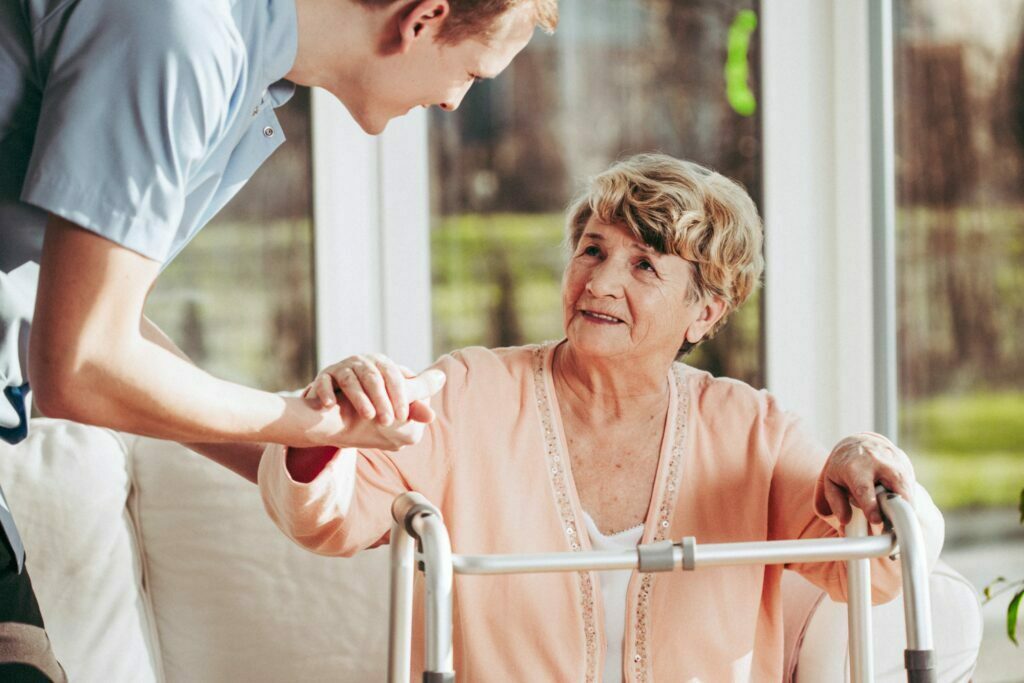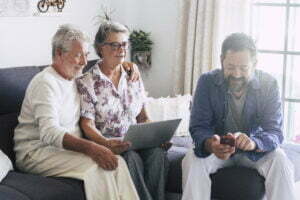The most frequent form of dementia is Alzheimer’s disease. Alzheimer’s disease was estimated to affect 5.8 million Americans last 2020[1]. Beyond the age of 65, the number of persons living with the condition doubles every 5 years[1]. In the United States, Alzheimer’s disease is one of the top ten leading causes of death and ranks as the fifth biggest cause of death in people aged 65 and up. It is also the 6th greatest cause of death among adults in the United States. Alzheimer’s disease death rates are rising, despite the fact that heart disease and cancer death rates are declining. Dementia, including Alzheimer’s disease, has been shown to be under-reported in death certificates, suggesting that the proportion of older people who die from Alzheimer’s could be higher.
How can we take advantage of recent advancements in innovative therapies and technologies to assist Alzheimer’s patients, caregivers, and providers? Telehealth, as well as a corresponding reform of the traditional care model like Remote Patient Monitoring, is one of the solutions. Before we tackle its advantages, let’s take a look at some relevant information about Alzheimer’s Disease:
What is Alzheimer’s Disease?
According to the National Institute of Neurological Disorders and Stroke, Alzheimer’s disease is a neurodegenerative and progressive disease that typically begins slowly and worsens over time that happens when nerve cells in the brain die. Parts of the brain that control thought, memory, and language are affected by Alzheimer’s disease. It is the cause of 60–70% of dementia cases[2]. A person with Alzheimer’s disease will have memory loss, cognitive decline, or behavioral abnormalities that are interfering with their capacity to function in daily life.
What are the signs and symptoms of Alzheimer’s disease?
Alzheimer’s disease is a progressive disease that can range from moderate to severe. The scale starts with mild impairment and progresses to moderate impairment before reaching severe cognitive deterioration. The three stages of Alzheimer’s disease will have some of the symptoms that characterize them from the other. Alzheimer’s disease in a mild form of the disease present with memory impairments and cognitive difficulties which can include performing daily tasks for longer than normal, having trouble managing money and financial states, wandering and becoming disoriented and personality and behavioral changes, such as being more quickly irritated or furious.
Alzheimer’s disease with a moderate severity affects the regions of the brain responsible for language, sensations, reasoning, and consciousness. The following symptoms like more confusion and memory loss, having a hard time recognizing friends or families, inability to pick up fresh information and having trouble completing activities that have multiple stages, having trouble adjusting to new situations, erratic conduct, hallucinations, delusions, or paranoia are all examples of hallucinations may occur as a result of this disease state.
Alzheimer’s disease in the severe form will have plaques and tangles that are prevalent throughout the brain causing the brain tissue to atrophy significantly. This can result in lack of communication, having trouble shifting positions or moving around without help, unintended passing of urine or feces and substantial short- and long-term memory loss. People with this stage of Alzheimer’s disease may require reliance on others for support and round-the-clock care and assistance with eating, moving, and personal hygiene.
How is Alzheimer’s disease diagnosed?
Alzheimer’s disease cannot be diagnosed with a single test. If a doctor detects the presence of the illness, they will inquire about the person’s symptoms, experiences, and medical history, as well as those of their family or careers. The ability to communicate the symptoms, as well as the opinion of a close family member or friend on symptoms and their impact on everyday life, are critical components of diagnosing Alzheimer’s disease. Friends and family members may detect dementia symptoms before the sufferer does. A diagnosis of Alzheimer’s disease is also based on memory and thinking ability tests administered by the healthcare professionals. To examine a person’s ability to think and recall, cognitive and memory tests are used. Other possible reasons can be ruled out through laboratory and imaging testing such as a thyroid disorder or vitamin deficiencies which are other potential causes of memory loss and confusion. Balance, perceptions, and reflexes are all tested as part of the neurological function testing. A brain scan, such as a CT scan or an MRI scan or genetic analysis can also be requested to rule out other diagnosis. Alzheimer’s disease, on the other hand, is only definitively identified after death, when a microscopic examination of the brain reveals the disease’s telltale plaques and tangles.
What is the impact of Alzheimer’s disease?
Alzheimer’s disease is more common in older people, although it may also be seen in younger individuals. It’s a gradual condition that starts with mild memory loss and progresses to the loss of ability to converse and respond to the environment. The disease’s symptoms might occur after the age of 60, and the risk increases with age. By 2060, affected individuals are expected to nearly triple to 14 million individuals[1]. Treatment expenses for Alzheimer’s disease last 2010 were expected to be between $159 and $215 billion per year[3]. By 2040, these expenditures are expected to reach between $379 and $500 billion per year[3].
Many Alzheimer’s patients are currently cared for at home by family members. Although most individuals are ready to help their loved ones and friends, caring for someone with Alzheimer’s disease at home can be challenging and exhausting at times. The caregiver adjusts to new levels of ability and behavioral patterns each day. People with Alzheimer’s disease frequently require more intense care as their disease progresses.
RPM Technology Solution for Alzheimer’s Disease
Using contemporary technology, new and improved approaches for correctly monitoring functional loss in all stages of Alzheimer’s disease may be achieved with the use of remote patient monitoring. Remote patient monitoring could lead to objective and real-life functional endpoints with greater sensitivity to pharmacological agent signal detection. Here are the 3 ways RPM helps patients with Alzheimer’s Disease:
1. Provides remote monitoring in a “real-world” setting like home
Remote patient monitoring devices, such as fixed sensors at home, smartphone apps with vital sign monitoring, and wearables (e.g. activity trackers), are non-invasive and can continually and objectively measure metrics. Remote patient monitoring devices are well suited to monitoring Alzheimer’s disease patients because they may assess processes in a “real-world” setting, and hence offer better ecological validity and sensitivity than traditional in-clinic assessments of function.
Remote patient monitoring devices have the potential to be more effective than typical clinical evaluations because they can monitor sleep, gait, and activities of daily living while the individual is at home. Remote patient monitoring devices do not rely on caregiver recall hence they are more objective and less stressful for the person with Alzheimer’s disease.
2. Ensures safety and convenience
Self-care is crucial, especially for people with Alzheimer’s disease. As a result, remote patient monitoring places a premium on the patient’s unique demands. Alzheimer’s disease makes it difficult to navigate safely and increases the risk of falling. Having appointments at home, without worries on transportation or navigating a new environment, can be safer than going to an office or clinic for monitoring. Remote patient monitoring ensures that the patient may efficiently manage their own health while also keeping track of critical information about their condition. Remote patient monitoring devices may help individuals with Alzheimer’s disease to have 24-hour access to their care teams, treatment plans, and personal health data. Hence, patients who participate in remote patient monitoring may feel less stress, with better sleep habits, and greater physical fitness.
3. Reduces healthcare costs
Remote patient monitoring is also cost-effective. Remote patient monitoring helps elderly individuals to stay at home longer while still receiving the care they require. This makes the option excellent for people who do not want to spend their golden years in a nursing home. Chronically unwell people can also benefit from it since people with Alzheimer’s disease at the later stage often have difficulty adjusting to new situations. Remote patient monitoring also avoid exposure to infectious illnesses in general preventing devastating repercussions for people with Alzheimer’s disease.
Takeaway
Alzheimer’s disease can have a significant impact on a person’s quality of life. Alzheimer’s disease is known to deteriorate over time, but treatment can help avoid symptoms and improve your quality of life. The disease wreaks impairs memory, thinking, learning, and organizational abilities, eventually impairing their capacity to perform basic everyday tasks. Alzheimer’s disease is not an inevitable component of growing older. But remote patient monitoring can improves the conditions for individuals with Alzheimer’s disease through chronic care management.
To know more about Real-time Continuous Remote Patient Monitoring, contact DrKumo Inc.
References:
- Centers for Disease Control and Prevention. (2020, October 26). What is alzheimer’s disease? Centers for Disease Control and Prevention. Retrieved from https://www.cdc.gov/aging/aginginfo/alzheimers.htm
- World Health Organization. (n.d.). Dementia. World Health Organization. Retrieved from https://www.who.int/en/news-room/fact-sheets/detail/dementia
- Hurd MD, Martorell P, Delavande A, Mullen KJ, Langa KM. Monetary costs of dementia in the United States. NEJM. 2013;368(14):1326-34.









